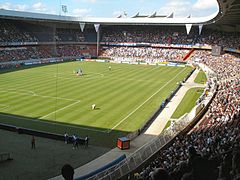Parc De Princes
 | |
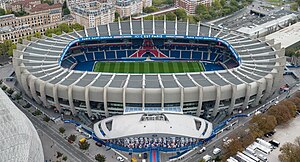 | |
 | |
| Address | 24 Rue du Commandant Guilbaud |
|---|---|
| Location | 75016 Paris, Île-de-France, France |
| Public transit | |
| Capacity | 48,229 |
| Record attendance | 50,370 (Rugby: France vs Wales, 18 February 1989) |
| Field size | 105 m × 68 m (344 ft × 223 ft) |
| Surface | GrassMaster by Tarkett Sports |
| Construction | |
| Built | 8 July 1967 |
| Opened | 25 May 1972 |
| Construction cost | 150 million FF (1970) (€179 million in 2022 euros) |
| Architect | Roger Taillibert & Siavash Teimouri |
| Tenants | |
| Paris FC (1972–1974, 1978–1979) Paris Saint-Germain (1974–present) France national football team (selected matches) France national rugby union team (1974–1998) | |
The Parc des Princes (French pronunciation: [paʁk de pʁɛ̃s], lit. 'Park of Princes') is an all-seater football stadium in Paris, France. It is located in the south-west of the French capital, inside the 16th arrondissement, near the Stade Jean-Bouin and Stade Roland Garros.
The stadium, with a seating capacity of 47,929 spectators, has been the home of football club Paris Saint-Germain (PSG) since 1974. Before the opening of the Stade de France in 1998, it was the home stadium of France's national football team and national rugby union team. The Parc des Princes pitch is surrounded by four covered all-seater stands, officially known as Tribune Borelli, Tribune Auteuil, Tribune Paris, and Tribune Boulogne.
Conceived by architect Roger Taillibert and Siavash Teimouri, the current version of the Parc des Princes officially opened on 25 May 1972, at a cost of 80–150 million francs. The stadium is the third to have been built on the site, the first opening its doors in 1897 and the second in 1932.
PSG registered its record home attendance in 1983, when 49,575 spectators witnessed the club's 2–0 win over Waterschei in the European Cup Winners' Cup quarter-finals. However, the France national rugby union team holds the stadium's absolute attendance record. They defeated Wales, 31–12, in the 1989 Five Nations Championship in front of 50,370 spectators.
History
Original stadium (1897–1932)

Originally called Stade Vélodrome du Parc des Princes, the stadium was inaugurated on 18 July 1897. Situated in the 16th arrondissement of Paris, the area was a forested parkland used by the royal family before the French Revolution. This gave the Parc des Princes its name.
With more than 3,000 seats, the velodrome had a 728-yard track. The director of the stadium, Henri Desgrange, was a former racing cyclist and founder of the cycling magazine L'Auto (predecessor of L'Équipe). The Parc des Princes marked the finish of the Tour from its first edition in 1903 until 1967. The 1900 UCI Track Cycling World Championships was held at the Parc des Princes.
In 1903, an English side easily defeated a team composed by the best Parisian players (11–0) in front of 984 paying spectators, in what was the first international football played at the Parc des Princes. In 1905, the France national football team contested its first ever home match against Switzerland, winning 1–0 at the Parc des Princes. Subsequently, the stadium welcomed further prestigious friendly games, but also four USFSA French Championship finals, as well as the 1919 Coupe de France Final between CASG Paris and Olympique de Paris in front of 10,000 spectators.
PSG's home also boasts a long history as an international rugby venue. In 1906, the France national rugby union team played their debut international, against the New Zealand national rugby union team. Other tenants included the Racing Club de France.
The stadium capacity was increased to 20,000 by the start of the 1924 Summer Olympics, held in Paris. However, Stade Olympique Yves-du-Manoir, which had been expanded to 60,000 seats, hosted the event.
Second stadium (1932–1972)
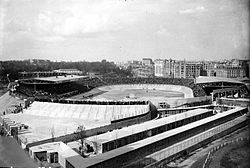
In the 1930s, L'Auto founder Henri Desgrange and his business partner Victor Goddet carried out a thorough reconstruction of the Parc des Princes and expanded it so that the sports arena had seats for 45,000 visitors, including 26,000 covered. The new stadium opened on 19 April 1932. Its capacity, however, was quickly reduced to 38,000 seats to improve comfort. The Parc des Princes hosted the opening match of the 1938 FIFA World Cup between Switzerland and Germany as well as the victory of Hungary in the semi-final against Sweden. But Stade Olympique Yves-du-Manoir continued to be more important, hosting the 1938 FIFA World Cup final in which Italy beat the Hungarians 4–2 to claim its second consecutive world title.
Following the Liberation of Paris in August 1944 and the end of World War II in September 1945, the French football championship returned, with big Parisian clubs Stade français-Red Star and Racing Paris regularly playing at the Parc des Princes. Still equipped with a cycling track of 454 metres, the Tour de France was not the only major sporting event hosted at this stadium. The Parc des Princes also hosted the 1954 Rugby League World Cup final, which saw Great Britain defeat hosts France in the inaugural staging of the Rugby League World Cup; Real Madrid's win over Stade de Reims in the first ever European Cup final in 1956; and the 1960 European Nations' Cup final, which saw the Soviet Union claim the first edition of the tournament after beating Yugoslavia.
Current stadium (1972–present)
Conceived by French architect Roger Taillibert and Iranian artist Siavash Teimouri, the third and current Parc des Princes is one of the continent's most emblematic and historic venues. It is a landmark and legally protected icon of French architecture. It was also the first stadium with lighting systems integrated onto its elliptical roof, and to this day is praised for its unique acoustics and its distinctive concrete ribs or razors.
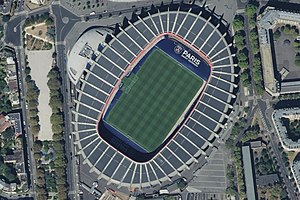
The inauguration of the Parc des Princes took place on 25 May 1972 on the occasion of the football match between France and USSR. The new stadium also hosted the 1972 Coupe de France Final between Olympique de Marseille and Bastia on 4 June 1972, and the 1972 Rugby League World Cup. That same year, Paris Saint-Germain – a fusion between Paris FC and Stade Saint-Germain – went through a bitter divorce. Paris FC remained in Ligue 1, while PSG kept their name but were administratively demoted to Division 3.
PSG played their first game at the Parc des Princes against Ligue 2 promotion rivals Red Star on 10 November 1973, as a curtain-raiser for that season's league season between Paris FC and Sochaux. PSG won 3–1 as Othniel Dossevi scored the club's first goal at the stadium. PSG returned to Ligue 1 in 1974, ironically the same year that Paris FC were relegated. They immediately moved into the Parc des Princes, which up until that point had been the home stadium of Paris FC. Before that, PSG had been playing at several grounds including the Stade Georges Lefèvre, the Stade Jean-Bouin, the Stade Bauer, and even the Parc des Princes a few times that season despite the reluctance of Paris FC. Thereafter, Paris FC and Racing Paris also played at the Parc des Princes while they were in Ligue 1 (until 1990), but never reaching the numbers of attendance leaders PSG.
Following its opening, the Parc des Princes finally became France's biggest stadium. This was where the national and international cup finals took place, including every single Coupe de France from 1972 to 1997, and three European club finals (the 1975 European Cup Final, the 1978 European Cup Winners' Cup Final, and the 1981 European Cup Final), and the 1991 Rugby World Cup. Most importantly, the Parc des Princes saw France defeat Spain in the UEFA Euro 1984 Final to claim its first-ever title. In 1992, France was named to host the 1998 World Cup. It was the country's first since 1938 and construction of a new arena began in May 1995, at the same time that Parc des Princes hosted the 1995 UEFA Cup Winners' Cup Final.
Inaugurated in January 1998, the Stade de France was the stadium of the future, while the Parc des Princes hosted its last international final that same year: the 1998 UEFA Cup Final. France have only played twice at the Parc des Princes since 1998: against Scotland during the UEFA Euro 2008 qualifiers in September 2007, and versus Australia in a friendly match in October 2013. Nonetheless, the stadium has still staged games at the 1998 FIFA World Cup, 2007 Rugby World Cup, UEFA Euro 2016 and 2019 FIFA Women's World Cup.
Renovation and expansion
In November 2013, PSG reached an agreement with the Paris City Council, owner of the Parc des Princes, to extend their stadium lease for a further 30 years until 2043, based on a fixed rent plus a variable share of their income. Subsequently, under the guidance of American architect Tom Sheehan, PSG completed a three-year €75 million upgrade of the Parc des Princes (2012, 2013–2014, 2015–2016) ahead of the UEFA Euro 2016 in France.
Two additional rows of seats were added, allowing the ground to remain at its current capacity, despite now boasting larger and more comfortable seats. Hospitality capacity went from 1,200 to 4,500, and new substitutes' benches and spacious, modern changing rooms that include warm-up and treatment rooms were installed. Carrying out this renovation work saw PSG's stadium revenue swell from €20m to €100m.
PSG are also looking to increase the capacity of their home to 60,000 in the coming years. From the start of their ownership at the club, Qatar Sports Investments (QSI) made it clear that a larger stadium is necessary to establish PSG as one of the leading European clubs. Originally, there were two options under consideration: move to the Stade de France or expand the Parc des Princes. The former was discarded following the redevelopments made to the Parc des Princes ahead of the Euro 2016. There have also been rumours that QSI are interested in buying the Parc des Princes for a fee believed to be around €150m.
Major tournament matches
FIFA World Cup

| Date | Team #1 | Result | Team #2 | Round | Attendance | Edition |
|---|---|---|---|---|---|---|
| 4 June 1938 | 1–1 (a.e.t.) | Round of 16 | 27,152 | 1938 FIFA World Cup | ||
| 9 June 1938 | 2–4 | Round of 16 replay | 20,025 | |||
| 16 June 1938 | 5–1 | Semi-finals | 20,000 | |||
| 15 June 1998 | 2–0 | Group stage | 45,500 | 1998 FIFA World Cup | ||
| 19 June 1998 | 1–0 | Group stage | 45,500 | |||
| 21 June 1998 | 5–0 | Group stage | 45,500 | |||
| 25 June 1998 | 1–1 | Group stage | 45,500 | |||
| 28 June 1998 | 4–1 | Round of 16 | 45,500 | |||
| 11 July 1998 | 1–2 | Third place play-off | 45,500 |
FIFA Women's World Cup

| Date | Team #1 | Result | Team #2 | Round | Attendance | Edition |
|---|---|---|---|---|---|---|
| 7 June 2019 | 4–0 | Group stage | 45,261 | 2019 FIFA Women's World Cup | ||
| 10 June 2019 | 0–0 | Group stage | 25,055 | |||
| 13 June 2019 | 0–1 | Group stage | 20,011 | |||
| 16 June 2019 | 3–0 | Group stage | 45,594 | |||
| 19 June 2019 | 3–3 | Group stage | 28,205 | |||
| 24 June 2019 | 1–0 | Round of 16 | 38,078 | |||
| 28 June 2019 | 1–2 | Quarter-finals | 45,595 |
UEFA European Championship
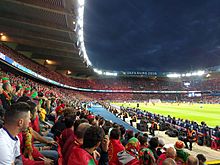
| Date | Team #1 | Result | Team #2 | Round | Attendance | Edition |
|---|---|---|---|---|---|---|
| 6 July 1960 | 4–5 | Semi-finals | 26,370 | 1960 European Nations' Cup | ||
| 10 July 1960 | 2–1 (a.e.t.) | Final | 17,966 | |||
| 12 June 1984 | 1–0 | Group stage | 47,570 | UEFA Euro 1984 | ||
| 20 June 1984 | 0–1 | Group stage | 47,691 | |||
| 27 June 1984 | 2–0 | Final | 47,368 | |||
| 12 June 2016 | 0–1 | Group stage | 43,842 | UEFA Euro 2016 | ||
| 15 June 2016 | 1–1 | Group stage | 43,576 | |||
| 18 June 2016 | 0–0 | Group stage | 44,291 | |||
| 21 June 2016 | 0–1 | Group stage | 44,125 | |||
| 25 June 2016 | 1–0 | Round of 16 | 44,342 |
UEFA Champions League
| Date | Team #1 | Result | Team #2 | Round | Attendance | Edition |
|---|---|---|---|---|---|---|
| 13 June 1956 | 4–3 | Final | 38,239 | 1955–56 European Cup | ||
| 28 May 1975 | 2–0 | Final | 48,374 | 1974–75 European Cup | ||
| 27 May 1981 | 1–0 | Final | 48,360 | 1980–81 European Cup |
UEFA Cup Winners' Cup
| Date | Team #1 | Result | Team #2 | Round | Attendance | Edition |
|---|---|---|---|---|---|---|
| 3 May 1978 | 4–0 | Final | 48,679 | 1977–78 European Cup Winners' Cup | ||
| 10 May 1995 | 1–2 | Final | 42,424 | 1994–95 UEFA Cup Winners' Cup |
UEFA Europa League
| Date | Team #1 | Result | Team #2 | Round | Attendance | Edition |
|---|---|---|---|---|---|---|
| 6 May 1998 | 0–3 | Final | 44,412 | 1997–98 UEFA Cup |
UEFA Super Cup
| Date | Team #1 | Result | Team #2 | Round | Attendance | Edition |
|---|---|---|---|---|---|---|
| 15 January 1997 | 1–6 | Final | 29,519 | 1996 UEFA Super Cup |
Latin Cup
| Date | Team #1 | Result | Team #2 | Round | Attendance | Edition |
|---|---|---|---|---|---|---|
| 29 June 1952 | 1–0 | Final | Unknown | 1952 Latin Cup | ||
| 26 June 1955 | 2–0 | Final | Unknown | 1955 Latin Cup |
Rugby World Cup

| Date | Team #1 | Result | Team #2 | Round | Attendance | Edition |
|---|---|---|---|---|---|---|
| 19 October 1991 | 10–19 | Quarter-finals | 48,500 | 1991 Rugby World Cup | ||
| 9 September 2007 | 59–7 | Pool stage | 46,575 | 2007 Rugby World Cup | ||
| 19 September 2007 | 31–5 | Pool stage | 45,476 | |||
| 28 September 2007 | 36–20 | Pool stage | 45,085 | |||
| 30 September 2007 | 15–30 | Pool stage | 45,450 | |||
| 19 October 2007 | 10–34 | Bronze final | 45,958 |
Rugby League World Cup
| Date | Team #1 | Result | Team #2 | Round | Attendance | Edition |
|---|---|---|---|---|---|---|
| 30 October 1954 | 22–13 | Group stage | 13,240 | 1954 Rugby League World Cup | ||
| 13 November 1954 | 12–16 | Final | 30,368 | |||
| 1 November 1972 | 9–5 | Group stage | 8,000 | 1972 Rugby League World Cup |
European Rugby Champions Cup
| Date | Team #1 | Result | Team #2 | Round | Attendance | Edition |
|---|---|---|---|---|---|---|
| 19 May 2001 | 30–34 | Final | 44,000 | 2000–01 Heineken Cup |
Summer Olympics

| Date | Team #1 | Result | Team #2 | Round | Attendance | Edition |
|---|---|---|---|---|---|---|
| 24 July 2024 | 1–2 | Men's group C | 33,732 | 2024 Summer Olympics | ||
| 24 July 2024 | 1–1 | Men's group D | 10,637 | |||
| 27 July 2024 | 2–4 | Men's group D | 28,887 | |||
| 28 July 2024 | 1–2 | Women's group C | 40,918 | |||
| 30 July 2024 | 1–1 | Men's group C | 30,475 | |||
| 30 July 2024 | 1–0 | Men's group D | 35,736 | |||
| 2 August 2024 | 4–0 | Men's quarter-finals | 42,868 | |||
| 3 August 2024 | 1–0 (a.e.t.) | Women's quarter-finals | 43,004 | |||
| 9 August 2024 | 3–5 (a.e.t.) | Men's final | 44,260 | |||
| 10 August 2024 | 0–1 | Women's final | 43,813 |
Concerts
Since its musical debut in June 1988, when Michael Jackson took the stage, the Parc des Princes has often hosted major concerts. Jackson played there again in 1997. The stadium was also used as a venue by other major artists, including The Rolling Stones and Prince in 1990, Johnny Hallyday in 1993, and David Bowie in 1997, as part of the Rock Festival in Paris. Following a show from U2 in 1997, the venue had a six-year musical hiatus.
Johnny Hallyday's second stint in June 2003, with four concerts to celebrate his 60th anniversary, reactivated the music scene at the Parc des Princes. He remains the singer who performed the most live concerts, seven in total. It subsequently welcomed the likes of Red Hot Chili Peppers (2004), Metallica (2004), Moby (2005), Iron Maiden (2005), Robbie Williams (2006), Muse (2007), Genesis (2007), Bruce Springsteen (2008), and Coldplay (2009). In June 2010, French hip hop group Suprême NTM and American rock band Green Day marked the last music chapter at the stadium in a long time.
In June 2022, DJ Snake became the first artist to perform at the Parc des Princes in twelve years. He was followed by French singer Dadju later that same month.
Average attendances
| Tenants | League season | Home games | Average attendance |
|---|---|---|---|
| Paris Saint-Germain | 2023-24 | 19 | 47,370 |
| Paris Saint-Germain | 2022-23 | 19 | 47,419 |
| Paris Saint-Germain | 2018-19 | 19 | 46,911 |
| Paris Saint-Germain | 2017-18 | 19 | 46,929 |
| Paris Saint-Germain | 2016-17 | 19 | 45,160 |
| Paris Saint-Germain | 2015-16 | 19 | 46,160 |
| Paris Saint-Germain | 2014-15 | 19 | 45,789 |
| Paris Saint-Germain | 2013-14 | 19 | 45,420 |
| Paris Saint-Germain | 2012-13 | 19 | 43,239 |
| Paris Saint-Germain | 2011-12 | 19 | 42,892 |
| Paris Saint-Germain | 2010-11 | 19 | 29,317 |
Gallery
-
Panorama view of the stadium
-
View of the pitch during UEFA Euro 2016
-
PSG ultras seen from the Boulogne stand, in 2006
See also
References
- ^ "Pouvoir d'achat de l'euro et du franc" (in French). Insee. Retrieved 15 December 2023.
- ^ Guillaume, Vincent (11 September 2022). "Souvenirs : Quand le PSG et le PFC jouaient ensemble au Parc des Princes !". Memosport.fr (in French). Retrieved 21 July 2023.
- ^ "Parc des Princes". Paris Organising Committee for the 2024 Olympic and Paralympic Games. Archived from the original on 15 August 2016. Retrieved 7 July 2016.
- ^ "Parc des Princes". UEFA.com. Union of European Football Associations. Archived from the original on 3 July 2016. Retrieved 7 July 2016.
- ^ "Parc des Princes". PSG.fr. Paris Saint-Germain. Archived from the original on 19 August 2017. Retrieved 19 July 2017.
- ^ "The lowdown on the Parc des Princes". RealMadrid.com. Real Madrid CF. 21 October 2015. Archived from the original on 16 August 2016. Retrieved 7 July 2016.
- ^ "Plan du Parc". PSG.fr (in French). Paris Saint-Germain. Archived from the original on 3 March 2017. Retrieved 2 March 2017.
- ^ "PSG firmly in the pantheon". FIFA.com. Fédération Internationale de Football Association. 17 October 2008. Archived from the original on 5 October 2015. Retrieved 18 June 2014.
- ^ "Le Parc des Princes". InfoPSG.com (in French). Archived from the original on 21 August 2016. Retrieved 7 July 2016.
- ^ "PSG-OM, record d'affluence au Parc des Princes en L1". Paris-canalhistorique.com (in French). 24 October 2016. Archived from the original on 23 November 2016. Retrieved 23 November 2016.
- ^ "Stadium and Attendances: Parc des Princes Paris". Stadium-Attendances.com. Archived from the original on 19 August 2016. Retrieved 7 July 2016.
- ^ "Parc des Princes". The Blizzard. 4 September 2017. Retrieved 14 March 2020.
- ^ "World Cup 1954". Rugby League Project. 10 March 2020. Retrieved 14 March 2020.
- ^ "Euro 2016: Parc des Princes". StadiumDB.com. Retrieved 7 July 2016.
- ^ "French Rugby Teams: Tradition, Talent, and Triumph". OVAL3. 29 November 2023. Retrieved 2 February 2024.
- ^ "Histoire du Paris Saint Germain". PSG70. Retrieved 2 April 2019.
- ^ "A brief history: Paris FC". thefootballcult – Medium. 16 January 2018. Retrieved 2 April 2019.
- ^ "Millième au Parc des Princes : ces dix matches qui ont fait l'histoire du PSG". Europe1. 9 September 2016. Retrieved 3 April 2019.
- ^ "1973 - 1978 : Paris se replace sur la scène française". Paris United. 19 November 2018. Retrieved 7 March 2019.
- ^ "Le PSG et Manchester City, les faux jumeaux". Le Monde. 5 April 2016. Retrieved 2 April 2019.
- ^ "Le grand retour des Bleus au Parc des Princes". Sport24 - Le Figaro. 10 October 2013. Retrieved 15 March 2020.
- ^ "Paris: PSG confirm next 30 years at Parc des Princes". StadiumDB.com. 27 November 2013. Retrieved 7 July 2016.
- ^ "Paris Saint-Germain finish Parc des Princes renovation but eye expansion". Goal.com. 11 May 2016. Retrieved 7 July 2016.
- ^ "Paris: 2024 Olympics could accelerate Parc des Princes expansion". StadiumDB.com. 11 May 2016. Retrieved 11 July 2016.
- ^ "Concerts au Parc des Princes, le retour". PSG.FR. 8 June 2022. Retrieved 12 August 2022.
- ^ https://www.european-football-statistics.co.uk/attn/nav/attnfra.htm


